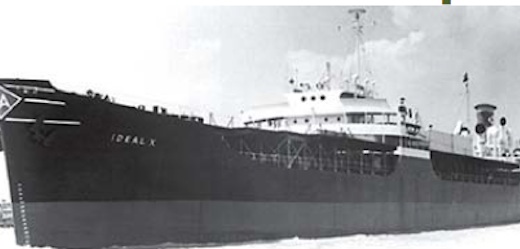
April 26 1956 the converted tanker Ideal X leaves Newark, New Jersey, carrying 58 cargo-laden truck-trailers on its specially fitted deck. Containerization is born. Globalization has set sail.
The first container ship was the brainchild of North Carolina businessman Malcolm McLean, who bought a second-hand truck in 1934 and built it into a fleet of nearly 1,800 trucks, the largest in the South and the fifth-largest in the nation. As early as 1937, he’d noted the wasted time of break-bulk cargo handling, with longshoremen or stevedores laboriously loading individual items like sacks of coffee or nets full of cotton bales.
He thought it would make much more sense to lift whole truck trailers on and off the ship. And he wanted to save taxes as well as time. Sending truck trailers by ship from one domestic port to another would avoid the state fees imposed for excess weight as a truck passed through a dozen or more states.
The Seatrain shipping line had carried railroad box cars on deck as early as 1929 on the New York–to–Cuba run. But McLean envisioned ships dedicated entirely to the new loading system. He wanted to separate the the truck container from its bed and wheels, and he conceived an angled-corner-post system to allow easy stacking and hold the containers in place.
So, he sold his trucking business (to avoid antitrust issues and the enmity of the established shipping lines), and bought Pan-Atlantic Tanker Co. He renamed it Sea-Land Shipping and beta-tested his idea with the Ideal X.
McLean’s gamble was closely watched, and by the time the ship arrived in Houston five days later, she already had space booked to ship containers north. The cost savings began immediately, and they got bigger. Ports needed to retool and install new, jumbo cranes, but more and more did so as they saw other containerized ports increase traffic. Ships were built to contain nothing but containers, above deck and below. Containers were soon standardized to make the system global. They’re now 8 feet wide, either 20 or 40 feet long, with heights of 8, 81⁄2 or 91⁄2 feet.
In a classic effect, increasing the nodes in the network increased the capabilities — and therefore the value — of every other part of the network. The U.S. military’s need to supply troops across the Pacific during the Vietnam War also provided a big push for containerization. And it proved the container ship in international rather than just domestic, coastal trade. About 90 percent of global cargo is now carried by container. Automobiles are the biggest exception, but thanks to refrigerated containers that plug in to shipboard electrical systems, food is not. The average cost of shipping a product overseas has fallen from 15 percent of retail to less than 1 percent. There’s less breakage and theft, but there is a downside. Ports handle more cargo, but there aren’t as many jobs for dockworkers. And low-cost goods from overseas have cost millions of jobs in developed economies. McLean was surely a visionary, but that doesn’t make him a saint.
Source: Wired News

